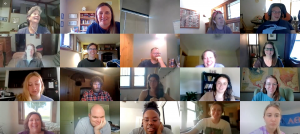Setting the Stage for Successful Planning
This summer, PFI board and staff pulled off an impressive feat – we crafted our strategic plan for 2021-2023 in a virtual setting. Typically, this is done in-person over two days, with lots of energy, laughs, food and deep thought. Though we were not meeting in person, we still managed to do all of these things. My considerate colleague Debra Boekholder even sent us all care packages with snacks from our members to enjoy during our planning. Practical Farmers’ strategic plan helps us work toward our long-term vision – an Iowa with healthy soil, healthy food, clean air, clean water, resilient farms and vibrant communities – by providing a guiding compass. It outlines a practical, nuts-and-bolts vision of what we can accomplish in three years.
Leading up to the strategic plan, we collected member surveys from nearly half of you. THANK YOU for filling these out. This survey tells us who you are, how well we are serving you and what our focus areas should be for the next few years. Read more about what we learned on pages 16-17. We also conducted visioning sessions and interviews to collect in-depth perspectives on how we’re doing. You strongly voiced your hope that we don’t sacrifice the good things we have going – including events, research and beginning farmer work – to add new areas of work. These sessions reaffirmed that Practical Farmers provides a strong sense of belonging and community. Members often have relationships with a multitude of members and staff. The support people feel from PFI enables them to continue to innovate and make changes. Cultivating this sense of belonging is the bedrock of what we do. Strengthening and expanding our network should be a top priority.
People feel our education is high quality and helps them make better decisions for their farms. Respondents also voiced areas we can improve, such as including economics more visibly in our work. Members see a need for more help in creating reliable markets for products, but they don’t have a clear vision of what this would look like. They have tasked us to come up with strategies toward long-term market solutions.

With virtual work and social distancing still in force as the coronavirus pandemic continues, virtual meetings like the one shown here are the typical way staff see one another these days.
Before delving as group into the findings from the member survey, visioning sessions and interviews, the board and staff gathered virtually to talk about COVID-19 and its implications for our work over the next three years. Group members expressed concerns, including how COVID-19 will impact our budget, how we continue to build connections while we’re forced into virtual spaces and whether farm consolidation could worsen due to economic fallouts of this pandemic. We also agreed the pandemic has revealed some silver linings, such as local food farmers stepping up and providing food along a shorter, and more resilient, food chain. Read about some of these innovative farmers on pages 6, 19, 20-27 and 34.
PFI staff also conducted an external environmental scan. This exercise helps us adapt to realities in the broader external environment so we can better reach our vision. Some trends – such as continued consolidation of farmland ownership, input supply businesses, processors and food retailers – can impede our work toward a more resilient agriculture. But people are also increasingly aware of how deeply entrenched systemic inequities in agriculture have significantly disadvantaged Black, Indigenous and other people of color. PFI will work to authentically welcome more diverse communities into our membership while continuing our efforts to build a more diverse landscape.
We know that preserving our farmer-led big tent is vital to PFI’s identity and impact. While this is essential to our approach, people behave based on the situations they find themselves in. Phillip Zimbardo, in his book “The Lucifer Effect,” writes that “unless we become sensitive to the real power of the System, which is invariably hidden behind a veil of secrecy, and fully understand its own set of rules and regulations, behavioral change will be transient and situational change illusory.”
Zimbardo likens creating substantive change to taking a public health approach, where the aim is to find what conditions foster illness rather than merely treating individuals on a case-by case basis. How do we do both? How do we nurture our farmer-to-farmer approach while still driving structural change that will help lay the groundwork for farmers to progress toward resiliency? This is a challenge we look forward to tackling with you all these next few years.
If you’d like to hear more about our findings, please let me know! Thanks for your participation and input to help us do better.
With a head full of information and hope,
Sally Worley
